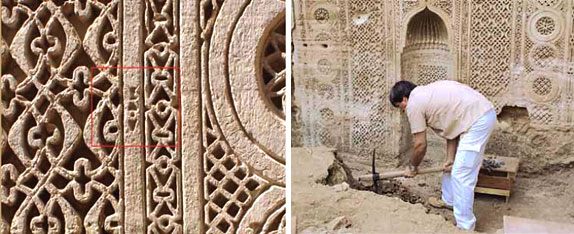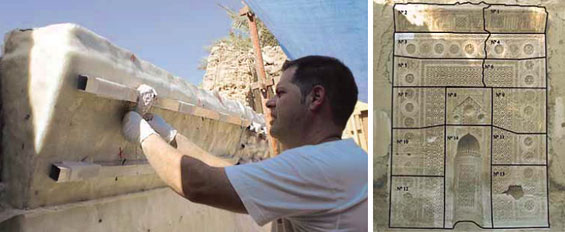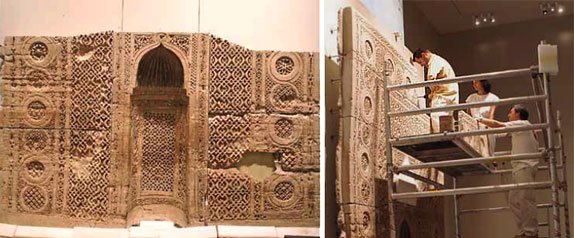When Acciona Producciones y Diseño offered us the chance to participate in the project to conserve, remove and install the Mihrab belonging to the Al Uwainah Mosque Wadi Bani Khalid, we were very aware of the difficulty and the professional challenge that this intervention meant.
In first place, it was a challenge due to the location of the monument itself. Secondly, we had no record of any work performed to detach a plaster work of these dimensions or at least we haven´t found it.

Our Company, Taller de Restauración el Barco, S.L., is a Spaniard firm, with wide experience in high complicated project and a deep will of internalization. Each project is different; however this one implied a big responsibility professionally speaking because we were dealing with one of the most important monuments of the Omani Heritage.
Immediately after accepting the challenge, a multidisciplinary team started to work to prepare the project and they studied the best methodology to face the intervention.
Similar experiences in the fields of archeology and wall painting were investigated, in order to find any information that may be useful to confront the project.

The first step was to visit the Mihrab in Wadi Bani Khalid and we took some samples of the supporting material, to be aware of what type of material we were about to work with, because at first sight, it seemed to be made of lime stucco. However, the analysis prove us wrong, and it confirmed that it was made of different plaster layers cooked at different temperatures, until reaching the superficial layer which was an anhydrite layer stronger than the rest, and water proof. It is very interesting to verify that the folk knowledge, without the actual sophistication, by simply intuition and empiric experience, is able to carry out the most accurate work to achieve the only goal of last longing. By the same token, we could confirm that the job was performed in “jornatas”(working days), such as in “al fresco” wall painting technique, on Mihrab´s case, the artesian applied fresh plaster and drew decorations by incision in location. All these clues were gathered to develop the methodology to detach the Mihrab in such a way that we planned the dismantling regarding to the way it was constructed.
After the study of the intervention, we rely on earlier experiences from other interventions to develop a system that would allow to assemble the plaster structure, which is a very fragile material that disintegrates easily, in this current case it was more concerning due to the conditions of the Mihrab that was uncovered, because the roof covering it fell down and the rubble hided part of it.

The chosen system was to create for the back side a resin and fiberglass structure to strengthen it and to insert stainless steel plates, which will be used as connectors to anchor the plates to a fixed structure in the Museum. This system was already used to a Project for the United States; It took us a long time of research and development to figure out how to avoid that the resin used for its consolidation had no impact on the art piece. Without a doubt, this system has facilitate the installation work and also, it makes each piece holds its own weight, avoiding weight tensions with the rest of the pieces.
All of technical details are further explained in the wide documentation prepared about this particular work which is attached bellow with an imagery report of each task.
